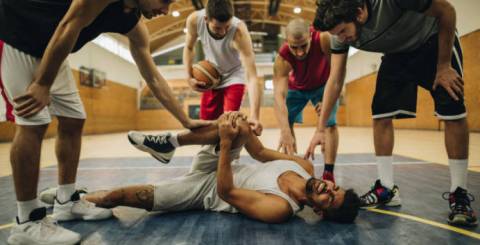Top 7 Common Basketball Injuries and Treatment Options

When it comes to the most common basketball injuries, some are widespread for players of all ages and ability levels, while others are only seen at the highest levels.
Preparation and training can lessen the likelihood of an accident occurring. Nonetheless, it's vital to remember that many sports injuries happen when you least expect them. Knowing about potential injuries ahead of time can help you prepare.
1. Ankle injuries
Ankle sprains are common among athletes and are produced when the ankle joint is rolled, twisted, or turned in a way that unduly stretches or tears soft tissue in the ankle joint.
Pain, inflammation, and even bruising are common side effects. This can impair your range of motion and keep you out of the game for several weeks if the damage is severe.
Ankle sprains, if left untreated, can progress to more serious conditions such as ankle tendonitis.
2. Achilles tendonitis
The Achilles tendon is the band of tissue that links the calf muscles to the heel bone. The Achilles tendon is constantly stretched in basketball and can develop microtears, leading to persistent inflammation and pain.
If the problem is not detected and treated, it will deteriorate, causing pain, limiting movement, and making it impossible to work at a high level.
3. Knee injuries
Basketball players ' knee joints are especially sensitive from jumper's knee, also known as Patellar Tendonitis, to ACL (anterior cruciate ligament) rupture.
A basketball knee injury can cause pain, inflammation, and joint weakening, all of which can lead to further damage if not treated.
Correct strength training, court technique, and warm-up and cool-down stretching are critical in preventing basketball knee injuries.
4. Deep thigh bruising
Physical contact between players on a crowded court is unavoidable in basketball amid the pandemonium of sprints resulting in jumps.
Deep bruising usually develops when a player's thigh collides with another player's knee or elbow with great force. Deep thigh bruising can result in discomfort, inflammation, and weakness that can last for several weeks.
5. Jammed fingers
During basketball, the fingers are virtually always at risk, from dribbling and passing to blocking and even dunking.
The joint might become stuck when the top of the finger makes contact with the ball, the rim, or another player.
This painful injury causes swelling and makes full use of the hands difficult. Preventing trapped fingers requires proper technique and awareness.
A jammed finger is not regarded as one of the worst basketball injuries, but it is one of the most common.
6. Stress fractures in the foot
When the muscles in the foot get too tired or abused to absorb the shock and stress of running, jumping, stopping, and sprinting, the bones become subject to microscopic cracks or breaks, known as fractures.
Stress fractures are frequently regarded as overuse injuries, although they can also be caused by ill-fitting or incorrect footwear, the playing surface, and returning to play too soon after an injury.
7. Muscle strains
Muscle strains, like sprains, occur when athletes stretch a specific muscle beyond its usual limit or impose an excessive weight on the muscle.
Because of the action involved in shooting, running, blocking, and passing shoulder and leg injuries are frequent in basketball. Athletes may suffer discomfort and inflammation in the strained muscle and a popping or snapping sound.
Treatment options for common basketball injuries
1. The RICE method
Rest, Ice, Compress, and Elevate. This cautious method of basketball injury treatment works well for small strains, bruising, and general muscle or bone concerns. It is most effective when administered within the first few days after an accident.
2. Taping and strapping
Taping and strapping can help support areas such as the elbows and knees, and the increased tension can alleviate muscular and soft-tissue stress.
Some players tape injury-prone areas before playing or training out to prevent injuries from occurring. This can assist players in continuing to train or play games.
3. EPAT therapy
EPAT Therapy is a noninvasive, painless way to hasten the healing process of several common basketball injuries. It increases blood flow and decreases inflammation in the affected area by using impulse pressure waves sent deep into muscles and tissue.
This sort of treatment, known as Shockwave Therapy, is employed by many college and professional basketball teams and trainers.
4. Nonsteroidal anti-inflammatory medications
Nonsteroidal anti-inflammatory drugs, such as ibuprofen, help relieve pain and reduce inflammation. These are non-prescription, over-the-counter drugs that are safe to use and do not require a prescription.
5. Physical therapy
Physical therapy can be an effective technique to strengthen the affected area and aid in rehabilitation for the majority of frequent basketball injuries, even minor ones. It is sometimes used in conjunction with other therapeutic approaches, such as EPAT Therapy, to expedite recovery and healing.
6. Surgery
Many of the frequent basketball injuries described below do not necessitate surgery. It is often reserved for the most severe basketball injuries, such as certain types of knee or ankle injuries. If the ailment is not too significant, professional athletes will opt for off-season surgery whenever possible.
Similar Articles
Knee pain affects millions of people around the world. It can make daily activities difficult and impact your quality of life. Knee discomfort can be caused by injuries, chronic conditions, or overuse.
If your knees have recently started sounding like a bowl of Rice Krispies (snap, crackle, pop!) every time you stand up, congratulations — you're officially living the adult experience.
Search engine optimization (SEO) may help physical therapists improve their online exposure and drive more visitors to their website.
You're sitting at home with two completely different treatment plans from two doctors you trust.
When conservative therapy fails, surgery may be required to alleviate chronic foot or ankle discomfort.
Your body changes with time - muscles and bones shift, ligaments loosen, and circulation may slow. Unfortunately, the aging process has an impact on our feet as well.
Back problems aren't just discomfort or temporary back pain. Many of them can be extremely dangerous and lead to serious complications if you don't seek medical attention on time.
Sciatica is a condition in which the sciatic nerve, the longest nerve in the human body, becomes irritated or pinched
Irritable bowel syndrome (IBS) is a dysfunction of the gastrointestinal tract that manifests as abdominal pain, bloating, flatulence, and intestinal discomfort (constipation, diarrhea, or a combination of both.









